
The cicadas are a superfamily, the Cicadoidea, of insects in the order Hemiptera. They are in the suborder Auchenorrhyncha, along with smaller jumping bugs such as leafhoppers and froghoppers. The superfamily is divided into two families, the Tettigarctidae, with two species in Australia, and the Cicadidae, with more than 3,000 species described from around the world; many species remain undescribed.

The clypeus is one of the sclerites that make up the face of an arthropod. In insects, the clypeus delimits the lower margin of the face, with the labrum articulated along the ventral margin of the clypeus. The mandibles bracket the labrum, but do not touch the clypeus. The dorsal margin of the clypeus is below the antennal sockets. The clypeus is often well-defined by sulci ("grooves") along its lateral and dorsal margins, and is most commonly rectangular or trapezoidal in overall shape.
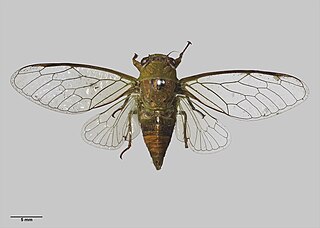
Kikihia is a genus of cicada in the family Cicadidae. Most species contained in the genus are endemic to New Zealand, with a single Australian species found on Norfolk Island. The genus was established in 1972 by John S. Dugdale with eleven species formerly classed within the genus Cicadetta.
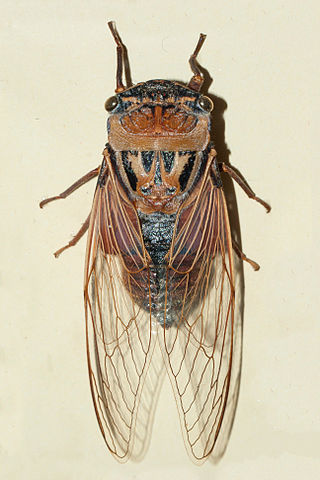
Thopha saccata, the double drummer, is the largest Australian species of cicada and reputedly the loudest insect in the world. Documented by the Danish zoologist Johan Christian Fabricius in 1803, it was the first described and named cicada native to Australia. Its common name comes from the large dark red-brown sac-like pockets that the adult male has on each side of its abdomen—the "double drums"—that are used to amplify the sound it produces.

Psaltoda moerens, commonly known as the redeye, is an Australian species of cicada. It is distributed through the south-east of Australia, from southern Queensland to South Australia, as well as Tasmania. Populations can vary greatly between years; one year they may be present in large numbers and the next they may be entirely absent. They feed primarily on eucalyptus but also on Angophora trees. As they feed on tree sap they expel small droplets of clear waste fluid. When numbers are high, this can form a constant stream.

Cyclochila australasiae is a species of cicada and one of Australia's most familiar insects. It is distributed through coastal regions of southeastern Australia. Green specimens are commonly known as green grocers and yellow ones as yellow mondays.
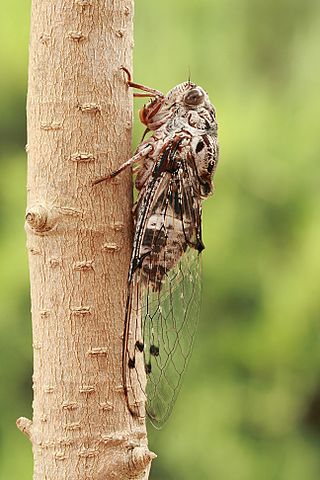
Aleeta curvicosta is a species of cicada, one of Australia's most familiar insects. Native to the continent's eastern coastline, it was described in 1834 by Ernst Friedrich Germar. The floury baker is the only described species in the genus Aleeta.

Psaltoda plaga is a species of cicada native to eastern Australia, from Maryborough in central Queensland to Bega in southern New South Wales. Adult cicadas appear over the summer and inhabit forested areas near bodies of water. The predominantly black form from the Sydney and Central Coast regions is commonly known as the black prince, while the term silver knight is used for the species as a whole.
Abricta is a genus of cicada found in Réunion, Mauritius, northeastern India, the Moluccas, New Caledonia and eastern Australia. They make a distinctive hissing sound when calling. Adult members of the genus usually face downwards on tree branches, and lay their eggs in living tissue. The genus was originally described by Carl Stål. The type species is Abricta brunnea from Mauritius and Reunion. However, recent review of the genus has shown it to be a disparate group of species, and the Australian members moved to other genera. S.M. Moulds conducted a morphological analysis of the genus and found the cicadas split naturally into clades according to biogeographical region. Of the 15 Australian species, the floury baker was the earliest offshoot. Unpublished data confirmed it was quite genetically distant from the other 14 species and so it was classified in a new monotypic genus Aleeta, while the others were placed in the genus Tryella.

Psaltoda is a genus of cicada found in eastern Australia. Originally described by Carl Stål, the type species is Psaltoda moerens known as the redeye, and P. plaga is a well-known species from eastern Australia, known as the black prince. Fifteen species are recognised. Relationships of the species with each other remains unclear.
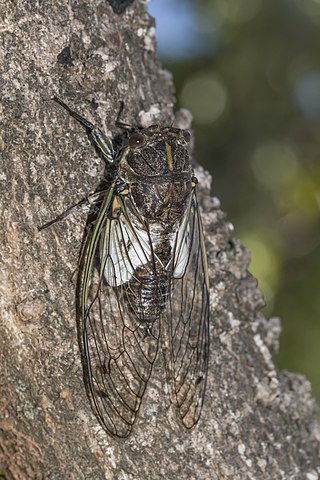
Arunta perulata is a large cicada native to Australia. It is also known as the white drummer cicada. The name floury baker was previously applied to this species, but that name is now specific to Aleeta curvicosta.

Cystosoma saundersii, commonly known as the bladder cicada, is a species of cicada native to northeastern New South Wales and southeastern Queensland in Australia.

Cyclochila is a genus of cicada native to eastern Australia. Two species are recognised, the greengrocer and the northern greengrocer.
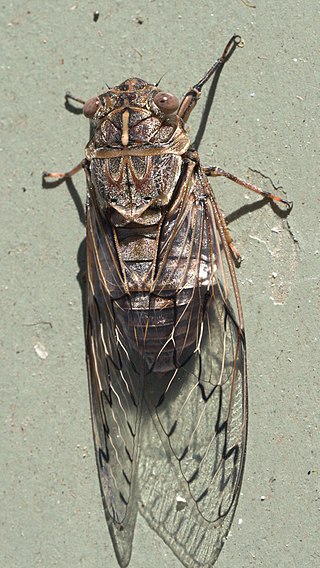
Henicopsaltria eydouxii, commonly known as the razor grinder, is a large species of cicada native to eastern Australia. Predominantly brown in colour, it is found in dry and wet sclerophyll forest in December and January and is quite common in Brisbane.
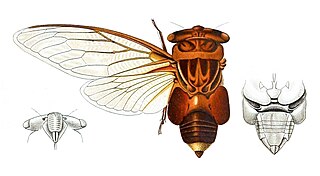
Thopha sessiliba, commonly known as the northern double drummer, is an Australian cicada native to Queensland, the Northern Territory and northern Western Australia. Adults perch almost exclusively on ghost gums.
Thopha colorata, commonly known as the golden drummer, is an Australian cicada native to Central Australia. Adult cicadas alight exclusively on river red gums. The nymph is 18–20 millimetres (0.71–0.79 in) long and is a dull brown colour.

Macrotristria angularis, commonly known as the cherrynose, is an Australian cicada native to eastern Australia, where it is found in sclerophyll forests.

Psaltoda harrisii, commonly known as the yellowbelly, is a species of cicada native to eastern Australia. It can be distinguished from the similar but larger Black prince, by noting the absence of a dark Z-shaped infuscation near the apex of the forewings, which is present on P. plaga.

Psaltoda flavescens, commonly known as the golden knight, is a species of cicada native to Queensland in eastern Australia.
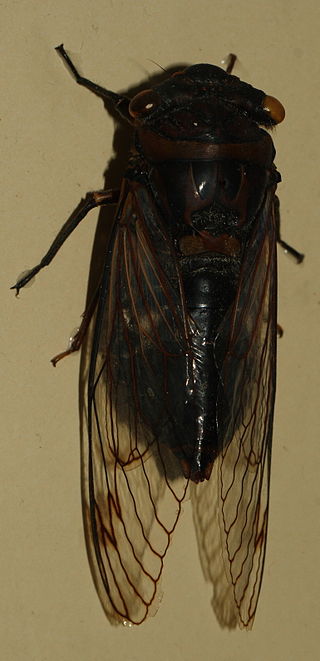
Psaltoda pictibasis, commonly known as the black friday, is a species of cicada native to Queensland and northeastern New South Wales in eastern Australia.

















